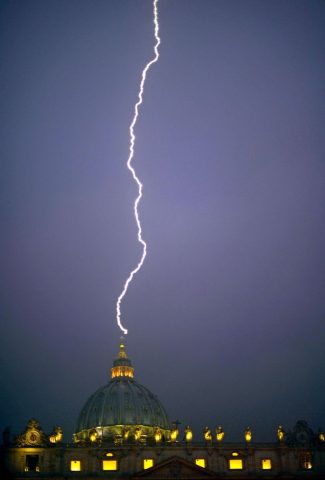Obama Unleashed a Genocide, and Trump Stopped It
October 9, 2018Daily Signal: The True Story of Kermit Gosnell and His Victims
October 9, 2018
By Marianna Bartold, Keeping It Catholic—The Blog, October 7, 2016
 Yes, it happened again. This morning in Rome, on the Feast of Our Lady of the Rosary, a lightning bolt hit the dome of St. Peter’s Basilica.
Yes, it happened again. This morning in Rome, on the Feast of Our Lady of the Rosary, a lightning bolt hit the dome of St. Peter’s Basilica.
“The bolt hit the dome of St. Peter’s at approximately 9:20 am., as a strong rainstorm passed through Rome. Vatican police confirmed the strike. No damage was reported. “Those close to the Vatican, from Swiss guards to local shop owners, felt the shock. “I was in the shower and heard what sounded like a loud thunder clap which lasted a few seconds andseemed to shake everything. I knew it was storming but it sounded more like an earthquake than a thunderstorm,” said one resident.
Most of us will remember that lightning twice struck St. Peter’s dome when Pope Benedict XVI announced his resignation of the papal throne. The date of his announcement? February 11—the Feast of Our Lady of Lourdes.
What Does It Mean?
To answer that question, we need to review a bit of history with a “Catholic conscience,” as Hilaire Bellloc coined the term.
First: Did you know that October 7 was originally the Feast of the Blessed Virgin Mother of Victory?
To commemorate the date of October 7, 1571 of the Catholic Armada’s victory over the Turks at the Battle of Lepanto, Pope Pius V introduced in 1572 the “festem BMV de victoria” (Feast of the Blessed Virgin Mother of Victory). This same Pope had earlier called all Christians to ardently pray the Rosary, for the Muslim threat had reached epic proportions. With constant supplications for the Virgin’s intercession, coupled with the great battle at Lepanto, the threat was turned back.
Two years later, the new pope, Gregory XIII, changed both the title and the date: The “Feast of the Holy Rosary” was to be celebrated on the first Sunday of October. At the time, the privilege of celebrating this feast was only granted to all churches with a Rosary altar. Later, Pope Clemens XI extended the feast to the universal Church.
Pope St. Pius X returned the feast day to its original date, October 7. In the early papacy of Pope John XXIII, the name was changed to “Feast of the Blessed Virgin Mary of the Rosary.” In 1969, the name was again changed to “Our Lady of the Rosary.” Today, the feast is celebrated as a mandatory memorial.
Second: As previously mentioned, Pope Benedict XVI announced his upcoming resignation on February 11, 2013, the Feast of Our Lady of Lourdes. On that very day, lightning struck the dome of St. Peter’s basilica—not once, but twice.
Let’s consider: What was the main message of Lourdes? It was three-fold: The daily Rosary, “Penance, penance, penance!” (as Bernadette quietly repeated during one apparition), and adoration of the Blessed Sacrament, where Our Lord is truly present. This is known by Our Lady’s “request” for a “chapel” and “Let processions come hither.”
There is yet another message of Lourdes, often overlooked as intended only for St. Bernadette: “I do not promise you happiness in this world but only in the other.” We , too, must offer, as our penance to God, our faithful adherence to daily duty (which has a two-fold direction: our duty as a Catholic and in of one’s state), as was proven by the life of the humble Bernadette. The same message about adherence to “daily duty” and accepting the sufferings that God allows or sends was repeated at the Fatima apparitions, first by the Angel Guardian of Portugal and, years later, by Our Lord to Lucia.
The Sign of Lourdes. After the parish priest of Lourdes directed Bernadette to ask for a specific sign (the blooming of the wild rose bush under the niche where the Lady stood), the Virgin directed the 14 year old Bernadette to a hidden spring, inside the Grotto’s confines and the River Gave. In following the Lady’s command, “Go to the spring, drink of it, and wash yourself there,” Bernadette was at first confused. She saw no spring, so she took a few steps toward the River Gave, when the Lady gently interrupted her, “No, the spring yonder” and indicated a particular spot. Bernadette went to it and felt impelled to dig into the ground. As a small amount of water came up, she rubbed her face with the mud, and also ate of the nearby wild plants, as Our Lady also told her. To the eyes of others, Bernadette’s actions appeared to be insane, and so she was called. In other words, for obeying a simple command of the Virgin which, to others, made no sense, the 14 year old saint was subjected to loud, public ridicule and humiliation.
But the child’s obedience to the Lady’s command brought forth a miracle. While the uncovered spring’s source is natural, the supernatural graces imparted through it are not. Since the year 1858, the water of Lourdes has brought to many the graces of spiritual conversion or restored bodily health, granted by God through the intercession of the Lady, who eventually revealed, “I am the Immaculate Conception.” The miraculous spring of Lourdes is a “sensible sign” (that is, a sign that one can perceive through one or more of the five senses of sight, hearing, touch, taste, or scent).
As I point out in my book (Fatima: The Signs and Secrets) when comparing Fatima, Lourdes, La Salette, and the Rue-de-bac: “Lourdes is the first of modern apparition sites which drew onlookers. St. Bernadette Soubirous stated that ‘the Lady’ who came to her simply appeared in the Grotto niche−but when pressed for details, she said that a ‘golden cloud’ within the niche quickly preceded the Lady’s appearance. The people who came to Lourdes during St. Bernadette’s apparitions would testify to the saint’s demeanor during her ecstasies, but none reported any sensible signs attesting to the Vision’s presence.”
Third: Such was not the case at Fatima, Portugal, and which (for many reasons) I have long described as “the crown of all Marian apparitions.” The first apparition of the Virgin occurred in May, 1917 and the only ones present were the three child visionaries. By June, word spread and people came, increasing in numbers, month by month.
It was also in June that the first “sensible sign” was seen by onlookers: a light cloud, traveling from east to west, serenely settling over a young holmoak tree upon which “the Lady” stood. The same cloud, after resting on the tree during the entire time of the Apparition, rose and departed from whence it came−toward the east.
What is truly incredible is that the visionaries themselves did not see this cloud. Over the course of five months, witnesses were graced with even more signs. The faithful were convinced that “the Lady” was the Virgin, but she did not announce her identity until October 13, 1917—the day of the promised sign, the Miracle of the Sun. On that day, the Madonna stated very simply: “I am the Lady of the Rosary.”
The Signs at Fatima
As I also address in my book, “witness testimonies reveal the following ‘sensible signs’ seen at Fatima over the course of five months” and then I explain the meaning of each of these signs, section by section:
“• A delicate white cloud, traveling from east to west, serenely settling over a young holmoak tree. The same cloud, after resting on the tree during the entire time of the Apparition, rose and departed from whence it came−toward the east.
“• In July (the month in which the Virgin gave the children a Great Secret), the cloud (mentioned above), three times curling and rising into the air during the whole time of the Apparition−as though invisible thurifers were liturgically incensing the Vision.
“• Claps of thunder, either as the Lady arrived or as she departed. (The day was clear and sunny.)
“• Flashes of light, seen only by the three children, as the Vision approached the small holmoak tree.(Again, the weather was fine.)
“• The ground of the apparition site momentarily trembling, like the briefest of earthquakes.
“• The branches and shoots of the young holmoak tree mysteriously bending to the east after the Apparition departed.
“• Atmospheric changes of the sky’s luminosity, similar to a solar eclipse, or changes of unusual color, from yellow gold to all the colors of the rainbow. Some people reported seeing stars in the sky at solar noon.
“• A relieving drop in temperature, during the hottest days of summer, accompanied by a cool fresh breeze.
“• Small, white objects described as stars, roses, or doves gently falling from the sky, only to disappear before touching the ground.
“• A globe of extraordinary light that glided, from east to west, descending toward the small holmoak tree.”
The Biblical Explanation of the Signs
of Thunder and Lightening
For the purposes of the current subject (lightening striking the dome of St. Peter’s), below I’ll share more excerpts from my book, which refer to the signs of lightning and thunder of the Fatima apparitions, and which were seen and heard on clear, sunny days:
-
In July, the month in which the Virgin Mary gave the three child visionaries the Great Secret of Fatima in its three distinct parts, a “large clap of thunder” was heard just seconds before the eldest child, Lucia, suddenly jumped up from her kneeling position, exclaiming, “There she goes! There she goes!” as the Lady departed. The thunder shook the ground, so that a small arch placed by the apparition site “trembled as if in an earthquake.
-
In August, when the children were not present at the apparition site because the mayor had abducted them, a great crowd gathered in anticipation of solar noon, the usual time of Our Lady’s appearance. When the hour arrived, the people heard an extremely loud boom of thunder, which so badly frightened them that many scattered and ran, thinking they would be killed.
-
A flash of lightning, following the thunder, was also seen in August, garnering the attention of the now-silenced crowd. This “flash,” always seen by the children, served as the sign of the Virgin’s approach but had never been previously perceived by the people.
In the Scriptures, the sound of thunder, the appearance of lightning, or the trembling of an earthquake announce a direct manifestation from the Lord or of the Lord. Thunder denotes God’s “voice”−i.e., His irrevocable declaration of His truth, mercy and judgment:“The Lord shall thunder from heaven: and the Most High shall give forth His voice.” (Here it should be noted again that only twice was thunder heard at Fatima−in July, after the Great Secret was divulged, and an even greater “boom” in August when the plotting mayor kidnapped the children. Recalling that thunder denotes God’s voice, often in judgment, we should also remember that Our Lady would, in August, tell the children, “If you had not been taken away to the City, the miracle would have been greater.”)
Lightning is the sign of God’s divine majesty and His wisdom and power in His wonderful works, His miracles, and His judgment. In the Book of Exodus, thunder and lightning together announce the Holy Presence of the Lord God immediately before He gave the Ten Commandments to Moses: “And now the third day was come, and the morning appeared: and behold thunders began to be heard, and lightning to flash, and a very thick cloud to cover the mount…and the people that were in the camp, feared.”
Both thunder and lightning are likewise found in the Psalms, representing Divine Revelation which enlightens the interior life of the soul, when King David mysteriously addressed the Lord: “The voice of thy thunder in a wheel. Thy lightnings enlightened the world: the earth shook and trembled.” As was mentioned earlier, an eyewitness of the Fatima apparition in July inadvertently chose similar words to those of King David when, at the moment the child Lucia exclaimed the Lady’s leave-taking, “the earth trembled like an earthquake.”
Most interesting, a witness in Rome to today’s lightning strike said something along the same lines: it “seemed to shake everything. I knew it was storming but it sounded more like an earthquake…”
If there is a message from God in the lightening that struck St. Peter’s (for the third time, on yet another feast day of Our Lady’s), it is this: Shirking the true duties of the Church and of the papal office will save no one. “Ecumenism” will save no one. Adapting the ways of the world will save no one. Making grand concessions to those who are—objectively speaking—in heresy, or schism, or mortal sin will not save souls. For my thoughts are not your thoughts: nor your ways my ways, saith the Lord (Isa. 55:88). What, then, shall save the Church and the world from the terrifying descent in which both are caught?
The answer is clear and wonderfully easy: Heed all of the “requests” of Our Lady of Fatima. (N.B. I’ve said it elsewhere, but it bears repeating: In the original Portuguese, the Virgin used the word “pedido,” meaning “order” or “command,” as in a “request” made by a superior to a subordinate. As we can see, Our Lady gave her commands with both a motherly and queenly grace.)
Simply stated, Our Lady of Fatima has waited almost 100 years for the Vicar of Christ to heed her requests for the following:
-
Worldwide devotion to the Immaculate Heart of Mary.
-
Papal promulgation of the Five First Saturdays of Reparation for the five major blasphemies committed against the Virgin’s Immaculate Heart.
-
The public dissemination of the Third Secret Text.
-
The solemn and public collegial consecration of Russia (and Russia alone) to the Immaculate Heart of Mary.
To repeat another excerpt from my book: “Individual Catholics can and do respond to the other requests made by the Blessed Mother at Fatima (daily Rosary, daily duty offered in penance, making sacrifices for the conversion of sinners, the wearing of the Brown Scapular, conscientiously striving not to offend the Lord our God any longer, and taking part in First Saturday devotions where they might be offered, or otherwise privately making the intention of reparation to the Immaculate Heart of Mary at a Saturday Mass when the intention is not publicly stated by the priest; the requirements include Confession, Holy Mass, Rosary, and 15 additional minutes on the 15 Rosary Mysteries of the Redemption).”
Why Such Simple “Requests”?
At Fatima, the Lady who eventually gave her name as “the Lady of the Rosary” said in July 1917 (the day she gave the Great Secret, in three distinct parts): “God wishes to establish in the world devotion to my Immaculate Heart.” That is the central message of Fatima–the “heart,” if you will, of God’s purpose.
Since 1929, no Pope has yet to fully obey the Queen and Mother of the Church. Whoever he may be, whether the present pope or a very-near future pope, the man holding the papal office must recognize and accept the power of his authority and jurisdiction (which is universal) and use it for the good of the Church and the world. The Pope needs nobody’s permission to command and lead the collegial consecration of Russia; he need not ask the cardinals, the bishops, or even Russia, for he alone is Pope and Steward of the Catholic City. Our Lady’s “requests” (again, “commands”) to the Pope, bishops, and the entire Church Militant still stand.
Finally, as we consider this recent sign, may we also recall what Pope Benedict XVI said in May, 2010: “We would be mistaken to think that Fatima’s prophetic mission is complete.”
________________________________
It’s where the Catholic Action is—a special spot for the those who are grateful to live in the Catholic City, wherever they may abide. Here you’ll find articles on the Faith, Fatima, Secrets of the Catholic City, Catholic family life and homeschooling—all with what Hilaire Belloc called “the Catholic conscience of history.”
- Marianna Bartold
- United States
- Marianna is the monthly columnist for “Secrets of the Catholic City,” published by Catholic Family News. The founding publisher of The Catholic Family’s Magnificat Magazine, she also became the first home education editor of Sursum Corda (later merged with Latin Mass magazine). Her contributors included Fr. John Hardon, S.J. (now Servant of God), Dr. Mary Kay Clark, Laura Berquist, and many others. An occasional contributor to papers like “The Wanderer” and speaker at Catholic homeschooling conferences, Marianna is the author of Fatima: The Signs and Secrets; Guadalupe: Secrets of the Image: Keeping It Catholic Home Education Guides, The Return of the King Study Guide, The Age of Mary Study Guides, and editor of The Divine Parables Explained (digital reprint) and of The Keepsake Collection. The driving force behind three Catholic support groups (local, state, and national), Marianna also gained valuable online experience as the Homeschooling Forum Moderator for CRNET (now EWTN Online, where many of her magazine’s articles are archived). In 1996, Marianna founded KIC – the Keeping It Catholic Faith, Family and Home Education Network



 Yes, it happened again. This morning in Rome, on the Feast of Our Lady of the Rosary, a lightning bolt hit the dome of St. Peter’s Basilica.
Yes, it happened again. This morning in Rome, on the Feast of Our Lady of the Rosary, a lightning bolt hit the dome of St. Peter’s Basilica.



